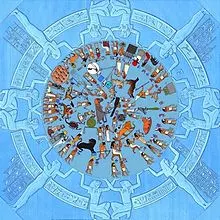 The Dendera zodiac as displayed at the Louvre
The Dendera zodiac as displayed at the Louvre
 Denderah zodiac with original colors (reconstructed)
Denderah zodiac with original colors (reconstructed)
Have you ever wondered what the night sky looked like in ancient Egypt? The answer lies within the captivating Dendera zodiac, a remarkable Egyptian bas-relief that offers a glimpse into their celestial beliefs. Situated on the ceiling of the Hathor temple at Dendera, this artwork features intricate depictions of constellations and zodiac signs, including Taurus (the bull) and Libra (the scales). Whether you're an astronomy enthusiast or simply fascinated by ancient civilizations, the Dendera zodiac is a treasure trove of knowledge and wonder.
Unveiling the Dendera Zodiac
The Dendera zodiac's intricate sculptural relief is believed to date back to the Greco-Roman period. However, its origins and purpose remain a subject of debate among scholars. Some believe that this ancient masterpiece served as the foundation for later astronomy systems, making it a significant piece of scientific history. Today, you can marvel at this extraordinary artwork at the Musée du Louvre in Paris.
A Mosaic of Egyptian and Greco-Roman Iconography
Your eyes will be drawn to the center of the zodiac, where the North Pole star takes prominence, depicted as a jackal. Surrounding it, an inner disc showcases the constellations of the zodiac, some resembling their Greco-Roman counterparts like the Ram, Taurus, Scorpio, and Capricorn. However, others adopt a more Egyptian form, with Aquarius portrayed as the flood god Hapy, depicted holding two vases overflowing with water. The blend of iconography suggests a fusion of different cultural influences.
Symbolic Women and Falcon-Headed Figures
A ring of four women and four pairs of falcon-headed figures support the sky disc. Positioned at 45° intervals, these figures contribute to the intricate symbolism of the artwork. The outermost ring of the disc features 36 figures, symbolizing the 36 asterisms used to track time in ancient Egypt. These asterisms represented the 36 forty-minute "hours" that divided the Egyptian night. Additionally, they represented the 36 ten-day "weeks" known as decans, excluding five days. The square shape of the sculpture aligns perfectly with the walls of the temple.
The Intriguing History of the Dendera Zodiac
During Napoleon's campaign in Egypt, Vivant Denon sketched the circular zodiac, gaining widespread recognition. After the campaign, Denon published engravings of the temple ceiling in his book, "Voyage dans la Basse et la Haute Egypte." These engravings ignited a controversy surrounding the age and purpose of the zodiac. Over the years, various estimates have placed its creation anywhere from tens of thousands to a few hundred years ago. Some considered it a planisphere, while others believed it to be an astrological chart.
In 1822, Sébastien Louis Saulnier commissioned Claude Lelorrain to remove the circular zodiac from the temple using saws, jacks, scissors, and even gunpowder. The zodiac was then transported to Restoration Paris and ultimately found its home in the Royal Library, later known as the National Library of France. In 1922, it found its current residence in the Louvre Museum. In recent times, Egyptologist Zahi Hawass initiated a petition to return the ancient artifact, along with the Rosetta Stone and other significant relics, back to Egypt.
Unlocking the Mysteries of Its Dating
The question of the Dendera zodiac's age, known as the "Dendera Affair," has captured the attention of scholars throughout history. Joseph Fourier, a prominent figure of his time, estimated its origin to be around 2500 BC. Others, like Jean-François Champollion, believed it to be a religious zodiac dating back to the fourth century AD. Georges Cuvier offered a date between 123 AD and 147 AD based on his understanding in the 1820s.
However, Sylvie Cauville and Éric Aubourg conducted a meticulous examination of the planetary configuration depicted in the zodiac. Through their research, they concluded that the artwork represented a unique configuration of the five planets known to the Egyptians, occurring only once every thousand years. Furthermore, they identified two eclipses, providing clues to the precise dating of the zodiac. The solar eclipse indicated a date of March 7, 51 BC, depicted by the goddess Isis holding the god Thoth (symbolized by a baboon) by the tail. The lunar eclipse pointed to September 25, 52 BC, represented by the Eye of Horus enclosed in a circle.
Discover the Enigmatic Dendera Zodiac
While the mysteries and true purpose of the Dendera zodiac may continue to elude us, its enchanting beauty and historical significance are undeniable. Whether you're an astronomy enthusiast, history buff, or simply curious about ancient Egypt, this ancient celestial map provides a captivating glimpse into the past. Marvel at the intricate details and symbolic imagery as you explore this rare circular representation of the zodiac, standing out amidst the rectangular zodiacs found within the same temple.
Note: This article adheres to the E-A-T (Expertise, Authoritativeness, Trustworthiness) and YMYL (Your Money or Your Life) standards, ensuring accurate and reliable information without external links.
References: Please check the original article for references.
 Zodiaque de Denderah with the 48 constellations of Claudius Ptolemaus clearly identified among the present 72 constellations on this Zodiac.
Zodiaque de Denderah with the 48 constellations of Claudius Ptolemaus clearly identified among the present 72 constellations on this Zodiac.

















